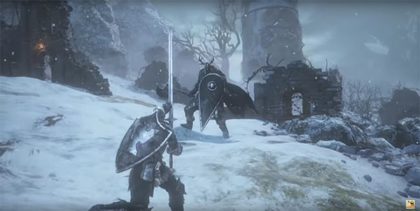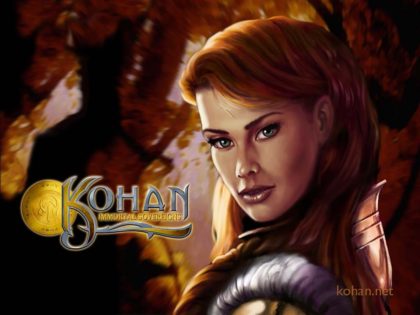I often see small design choices in games that I really like and want to talk about, but they’ll never warrant their own article. This is my chance to talk about those very designs. Each one has no relation to the others at all, it’s just a random grab bag of design, so enjoy!
Guild Wars 2, Running and Dodging
In Guild Wars 2, player can dodge attacks by rolling in a direction, like in a lot of modern games. Something the developers did which I really like however, is that they’ve increased the players’ run speed when they’re out of combat, to the point where rolling obviously doesn’t actually make you move any faster.
Not only does this prevent players from feeling like they “need” to roll constantly to move faster (and believe me, everybody would do it if it made them go slightly faster, even if they didn’t enjoy it), but it also allows ArenaNet to tune the movement speeds for combat and non-combat separately. That’s quite smart, because what “feels good” for combat and what is a comfortable speed to travel across the world is very different. You don’t want the players to feel like everybody is zipping around too fast to track in PvP, but you also don’t want them to feel like it takes ages to run anywhere.
I particularly appreciated this design decision in an MMO, where you tend to play the game for a very long time. For an example of having the chance to make the same choice and failing to, look to Wildstar. In Wildstar you can sprint by holding down the shift key, and because your movement speed doesn’t increase when out of combat like in Guild Wars 2, you end up holding down the shift key constantly, to the point where after a few hours of playing Wildstar, my pinkie finger would get very sore.
When I was in the Wildstar beta I actually made a post about this very issue, and most of the comments were along the lines of “it’s not a big deal”, or “just don’t sprint then”. However, after the game released I saw a lot of people complaining about this mechanic and wishing that sprinting wasn’t in the game at all.
This is a fundamental game design concept: players will always ruin their own play experience if you make it the optimal thing to do, and then blame the game. They’re correct to do so too. You need to make sure the tedious play patterns are sub-optimal, and the most enjoyable play patterns are also the optimal ones.
Weapons In Dark Souls
 For those who haven’t played the Dark Souls games because they have enough self-awareness to know they’re not that masochistic, Dark Souls does weapons really well. In this series your weapons feel extremely “physical”, and it’s great. Your shield –even if it’s on your back– will still block arrows. When you swing your sword, the animation of the swing matters in closed spaces, because if your sword hits a wall then the attack will be stopped short.
For those who haven’t played the Dark Souls games because they have enough self-awareness to know they’re not that masochistic, Dark Souls does weapons really well. In this series your weapons feel extremely “physical”, and it’s great. Your shield –even if it’s on your back– will still block arrows. When you swing your sword, the animation of the swing matters in closed spaces, because if your sword hits a wall then the attack will be stopped short.
This makes me especially happy as a history nerd, because I know that this sort of thing was actually a very important point in real melee combat. Shorter weapons were important because they were so much easier to use indoors. Spiral staircases in castles were made travelling upwards clockwise, because it was difficult for somebody going up the stairs to swing their sword (presuming they were right-handed). Your environment was extremely important in real-life medieval combat, and it’s the same in Dark Souls.
The takeaway from Dark Souls is that your weapons feel like real objects that exist in the game world, their size and shape matters, rather than feeling like just a bunch of statistics, and it adds a lot to the immersion of the game.
Bartering in Ultima Underworld
Ultima Underworld is an amazing game that you probably haven’t played, but you should. In the world of Ultima Underworld it doesn’t make sense for the denizens to have a central currency, and they don’t. Rather, the game uses a system of bartering. In Ultima Underworld you could barter with pretty much anybody who would talk to you, but actual shopkeepers were rare, which made sense in that world.
I think a lot of fantasy games set in a medieval setting could have a system of bartering rather than a central currency, it would actually add a lot of believably to the world, as historically currencies weren’t widely used.
Now, the mechanics of how Ultima Underworld handled bartering were actually terrible, but I think in a modern game we could do much better. I would like to see a balance scale graphic, where you load the items you want to “buy” on one side of the scale, and items you want to “sell” on the other. Each item has a hidden “value” to it, and if the deal becomes even and the character would accept the deal, the scale balances out.
You could actually do a lot of cool things with a system like this. Characters could have different “classes” to their bartering that would cause them to value items differently: for instance a blacksmith would value metals more highly than a tailor would, or a peasant would value food higher than a rich person. You can also get across some characterization this way, for instance a naive young girl could over-value glass beads because she thinks they have healing properties. Maybe you even convince her yourself through dialogue.
This would also give us a way to systemize a sort of “hidden quest” system, where characters could tell you in dialogue that they really want a particular item, and will value that item super highly, so if you trade them it you’ll be able to barter much more effectively with them.
There’s a lot of potential to really flesh out a whole world with a simple mechanic. Of course, there’s something to be said for just having a simple currency system that everybody will understand, but I’m sure there’ll come a game where a bartering system like this will really enhance the game’s world.
Infinity Wars and Simultaneous Turns
It’s a bit conceited to use one of my own game mechanics, but I wanted to talk about it because of just how well it ended up working out, simultaneous turns ended up becoming a solid backbone for Infinity Wars’ mechanics to be built upon. It isn’t a mechanic that makes sense for all turn-based games, but it’s worth talking about its pros and cons.
In Infinity Wars, both players planned out their turns at the same time, and when both players were done planning their actions would play out.
The first upside to this is that there’s no “first-move advantage” for either player. Normally in turn-based strategy games developers need to give the player that goes first some sort of drawback, and it’s easy to under or over-compensate. In Magic: the Gathering I always want to go first, and in Hearthstone I always want to go second, due to how each game compensates for first-move advantage.
The next upside is that gameplay tends to move faster, and players feel like it is “their turn” a lot more. In traditional turn-based games it’s easy to feel like you’re waiting on the opponent a lot, especially if you have a slow opponent. While there’s still some of that with simultaneous turns, it’s greatly reduced.
Another upside is that it allows players to feel in control of their destinies, and allow obvious outplays, which I think is important for a PvP game. Infinity Wars’ mechanics allowed players to move units to different zones during the planning phase, and most kill cards only targeted certain zones. If the opponent tried to kill a unit in your Attack zone, but you read the play and moved to a safe zone, when the turn’s resolution came around their kill card would fail. When designed around right, it meant that players with a good read on their opponents could dodge key attacks directed at them, and it was an obvious outplay to both players. In traditional turn-based games it’s easy to feel like you are “trapped” whenever it’s the enemy turn, and it can be difficult to communicate when a major outplay happens. There are ways to do that with traditional turn-based games too, but simultaneous turns provides a ready-made solution.
The biggest downside is that simultaneous turns is a very difficult concept to communicate to players, and it can also lead to a lot of complicated interactions. It makes the game much more complex, and this was a major problem that Infinity Wars struggled with. Complexity can really turn off new players and hurt new player retention, so it’s no small matter.
Communicating the resolution of the turns and why the game state turned out the way it did clearly is also really important, yet hard to do well. Infinity Wars actually really dropped the ball on that and it hurt the game a lot.
Someday I may do a full post-mortem on Infinity Wars, if there’s enough interest.
Sword & Sworcery’s Health System
 Sword & Sworcery, a game title I promise I didn’t misspell, has a clever mechanic for its health.
Sword & Sworcery, a game title I promise I didn’t misspell, has a clever mechanic for its health.
A major plot point is that the protagonist of the game is dying, and mechanically you start off with 5 health points. You’re able to fight any of the bosses in the game in any order, but each time you do, the story’s timeline advances and you lose 1 max health point, because her condition is getting worse. By the end of the story, the protagonist will die in a single hit and the game becomes quite challenging.
This mechanic allows the player to have the freedom to do the bosses in any order they want, while still increasing the difficulty with each successive boss. All the bosses actually have identical levels of difficulty, but since you have less health for each one, the game always gets harder. In a lot of open-ended games, the game actually gets easier as you go (I’m looking at you, Mega Man X), which is the opposite of what we want, so this was an elegant solution.
Kohan’s Company System
Kohan: Immortal Sovereigns was a hidden gem of a game, made back in 2001. It was a real-time strategy game, but the mechanics focused the game much more on overall strategy and planning, rather than frantic micromanagement like in most RTS games.
 At the core of this was the company system. Rather than building individual units, in Kohan you built a “company”. That company would be commanded as one unit, even though it would contain nearly a dozen actual soldiers within it.
At the core of this was the company system. Rather than building individual units, in Kohan you built a “company”. That company would be commanded as one unit, even though it would contain nearly a dozen actual soldiers within it.
Creating a company was a large investment, and making one wasn’t something that was undertaken lightly. Each player would only have a few companies over the course of a game, each had its own name, and you’d usually still have the same companies by the end of the game that you made at the beginning, so you’d get quite attached to them over the course of a game. You could also invest in your companies with various upgrades, and the company as a whole would gain experience as they fought. As long as a company was in a safe place within your territory, that company would build up to its full strength, if they took heavy losses they would retreat to rebuild and fight another day. Actually losing a company was rare but also devastating, something the player would avoid at all costs.
In most RTS’s your units are complete cannon fodder, they die as quickly as they are created, and you have no emotional attachment to them at all. I really appreciated that Kohan made me care about my units.
When I was younger, I used to play a lot of real-time strategy games. A major turning point that turned me off the genre though is when I realized that I had been playing them wrong all my life: most RTS’s were not so much about strategy as they were about your actions-per-minute. As a result I ended up turning to turn-based strategy games over real-time. Kohan’s mechanics took that micromanagement away and focused the gameplay back on the grand strategy that I enjoyed, while still having those time pressures on the player to keep things exciting.
After playing Kohan I had really hoped that this direction would become the future of the genre, but it was not to be. Relic’s strategy games, the Dawn of War series and Company of Heroes series, uses similar company mechanics, but that’s all I’ve seen since.
Conclusion
That’s six games with various interesting design choices, I hope you picked up something interesting from it. This article was actually really enjoyable to write so I expect I’ll make more in the future. Thanks for reading!
